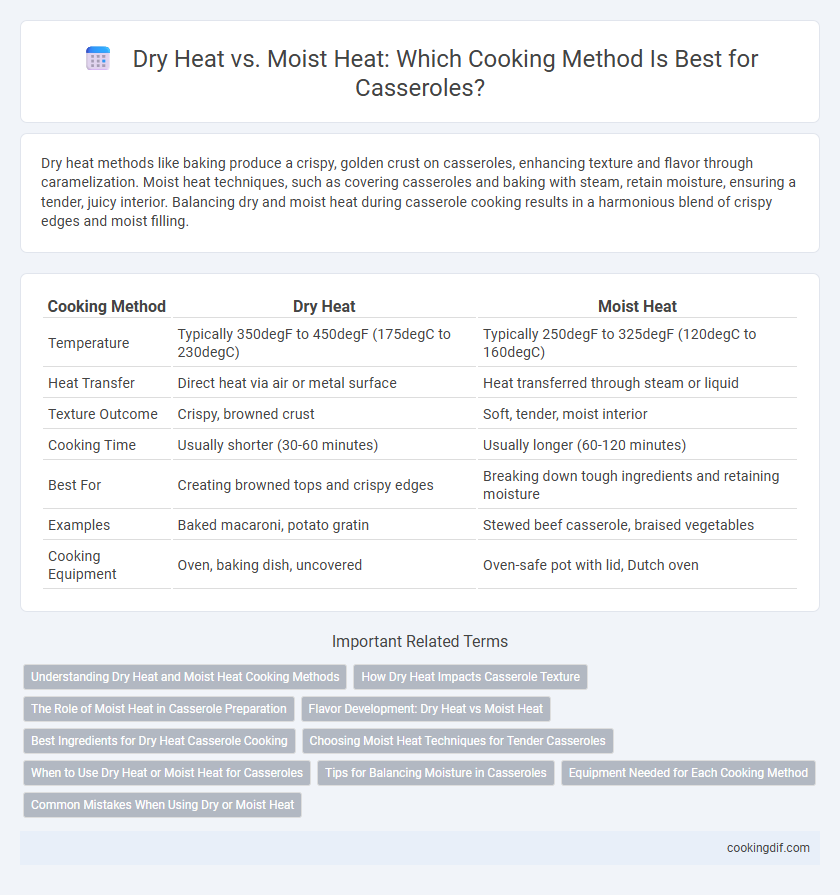Dry heat methods like baking produce a crispy, golden crust on casseroles, enhancing texture and flavor through caramelization. Moist heat techniques, such as covering casseroles and baking with steam, retain moisture, ensuring a tender, juicy interior. Balancing dry and moist heat during casserole cooking results in a harmonious blend of crispy edges and moist filling.
Table of Comparison
| Cooking Method | Dry Heat | Moist Heat |
|---|---|---|
| Temperature | Typically 350degF to 450degF (175degC to 230degC) | Typically 250degF to 325degF (120degC to 160degC) |
| Heat Transfer | Direct heat via air or metal surface | Heat transferred through steam or liquid |
| Texture Outcome | Crispy, browned crust | Soft, tender, moist interior |
| Cooking Time | Usually shorter (30-60 minutes) | Usually longer (60-120 minutes) |
| Best For | Creating browned tops and crispy edges | Breaking down tough ingredients and retaining moisture |
| Examples | Baked macaroni, potato gratin | Stewed beef casserole, braised vegetables |
| Cooking Equipment | Oven, baking dish, uncovered | Oven-safe pot with lid, Dutch oven |
Understanding Dry Heat and Moist Heat Cooking Methods
Dry heat cooking methods for casseroles involve using high temperatures without moisture, such as baking or roasting, to create a crispy, browned exterior and concentrated flavors. Moist heat cooking employs steam or liquid, like braising or simmering, which tenderizes ingredients and helps develop rich, saucy textures. Selecting between dry and moist heat techniques impacts the casserole's texture, flavor depth, and overall cooking time significantly.
How Dry Heat Impacts Casserole Texture
Dry heat cooking methods like baking or roasting create a crispy, browned crust on casseroles through the Maillard reaction, enhancing texture contrast. This dry heat environment allows moisture to evaporate, concentrating flavors and firming the casserole's top layer. As a result, casseroles cooked with dry heat typically have a crunchy, golden surface paired with a tender interior.
The Role of Moist Heat in Casserole Preparation
Moist heat plays a crucial role in casserole preparation by breaking down tough fibers in meats and vegetables, leading to tender, flavorful results. Techniques such as simmering or baking with liquids create an even cooking environment that allows ingredients to absorb flavors deeply. This method preserves moisture, preventing dryness and enhancing the overall texture of the casserole.
Flavor Development: Dry Heat vs Moist Heat
Dry heat cooking methods like baking or roasting enhance casserole flavor through Maillard reactions and caramelization, creating complex, rich, and browned notes. Moist heat techniques such as braising or simmering promote ingredient tenderness and meld flavors deeply but may result in a milder, less concentrated taste. Balancing dry and moist heat optimizes savory depth and textural contrast in casseroles.
Best Ingredients for Dry Heat Casserole Cooking
Dry heat casserole cooking excels with ingredients that develop rich, caramelized flavors and maintain structure, such as root vegetables, dense meats like beef or lamb, and hearty grains. These components withstand prolonged exposure to oven heat without becoming overly soft, allowing Maillard reaction to enhance taste and texture. Choosing items like potatoes, carrots, and firm cuts ensures optimal results in dry heat-method casseroles.
Choosing Moist Heat Techniques for Tender Casseroles
Moist heat techniques such as braising or simmering are ideal for casseroles to ensure ingredients become tender and flavors meld thoroughly. Using moist heat at lower temperatures allows collagen in meats and fibers in vegetables to break down, producing a succulent texture and rich taste. This method prevents dryness and enhances the overall mouthfeel, making casseroles more enjoyable and satisfying.
When to Use Dry Heat or Moist Heat for Casseroles
Use dry heat for casseroles featuring crispy toppings or browned surfaces, such as breadcrumb or cheese crusts, to achieve a golden, textured finish during baking. Opt for moist heat when cooking casseroles with dense or starchy ingredients like rice, beans, or meats requiring slow, even cooking to retain moisture and tenderness. Combining both methods, pre-cooking ingredients with moist heat before finishing with dry heat in the oven ensures optimal flavor development and texture contrast.
Tips for Balancing Moisture in Casseroles
Balancing moisture in casseroles requires understanding dry heat methods like baking, which create a browned, crispy top, versus moist heat from covered cooking that retains steam and prevents drying out. Use foil tenting or partially uncovered baking to allow moisture to escape while preserving tenderness, ensuring the dish doesn't become soggy or overly dry. Incorporating ingredients with natural moisture, such as vegetables or sauces, helps maintain an ideal texture throughout cooking.
Equipment Needed for Each Cooking Method
Dry heat cooking methods for casseroles typically require an oven and a heavy-duty, oven-safe dish like a cast iron or ceramic casserole dish to evenly distribute heat and achieve a browned, crispy top. Moist heat methods involve using equipment such as a covered Dutch oven or slow cooker that traps steam and maintains a humid environment, promoting tender, flavorful results. Choosing the right equipment ensures optimal texture and flavor by aligning with the specific heat transfer properties of dry or moist cooking methods.
Common Mistakes When Using Dry or Moist Heat
Using dry heat for casseroles, such as baking without a liquid base, can lead to overcooking and drying out the dish, resulting in a tough texture and uneven cooking. Moist heat methods, like adding broths or sauces, often cause casseroles to become soggy or lose desired crispness on the top layer. Common mistakes include failing to balance moisture levels to maintain structure while ensuring tenderness, and not adjusting cooking times to accommodate the heat method chosen.
Dry Heat vs Moist Heat for casserole cooking Infographic

 cookingdif.com
cookingdif.com